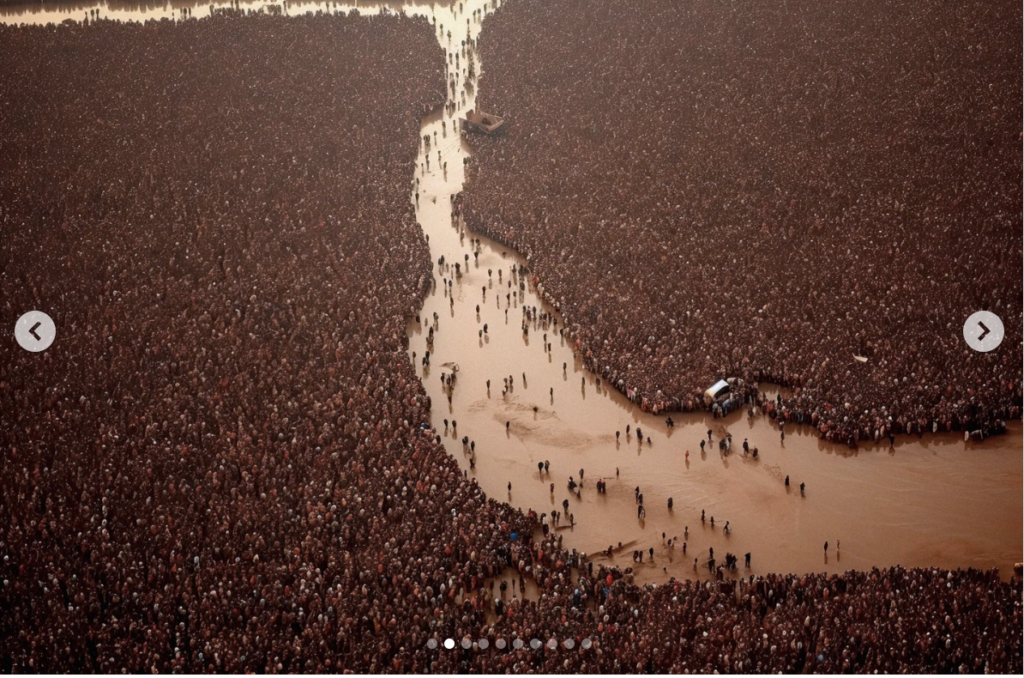
THIS IS NOT MY WORK.
I want to be clear about that upfront!
This work is done by a Turkish artist named Alkan Avcioglu, and it is part of his series, “Overpopulated Symphonies.” I found this amazing work on the Insta page of another photographer whose work I follow closely, Alejandro Cartagena. Cartagena is a Domican-born Mexican photographer whose work focuses on the effects of suburban sprawl on population growth and the environment in his city, Monterrey, Mexico. One of my favorite of Cartagena’s projects is Carpoolers (2014), where he photographed construction workers from above, traveling to work along Mexican Federal Highway 85 in the back of their contractors’ trucks. That highway links the city center and its wealthier parts with the surrounding suburban sprawl.
Quick aside: This is one of the amazing benefits of Instagram: finding the work of artists that artists I admire are following and getting excited about.I don’t believe I would have found Alkan Avcioglu anytime soon.
Avcioglu’s work is done using AI.
As Cartagena says about the work (he worked with Avcioglu):
“…’Overpopulated Symphonies’ hit me straight away as an important use of AI to create images that comment on our current human condition. The curation process led us to many areas of exploration: world politics, immigration, food supply, labor, housing, connectivity, excess and lack of access to information.”
And here is what Avcioglu writes:
“Overpopulated Symphonies” is a collection of AI post-photography that immerses viewers in a commentary on the contemporary human condition. Through sprawling images of densely populated urban landscapes and human gatherings, the collection reduces individuals to minuscule points, forming an overwhelming sea of indistinguishable dots.
“Beyond the literal portrayal of overpopulation, this collection utilizes the metaphor of crowd density as an analogy for the inundation of information in our modern era. It poses questions about identity, individuality, and the struggles faced by the human mind in processing and prioritizing the relentless surge of data we encounter daily. The figures in these photographs transcend mere physical bodies; they represent thoughts, ideas, and information, all vying for recognition and space within the confines of our mental landscapes. With humans depicted as dots in a chaotic neural network, these artworks serve as an allegory for the phenomenon of information overload.”
More here.
I am working with AI right now. As you might know from previous blog posts or from my Insta account, I am recreating the Russian Jewish shtetl of Liuh (no longer in existence) in 1911, the year my grandmother — then 14 years old — left for America. In the course of sharing some of this work, I have had a range of reactions. The least helpful was from a woman I barely knew who posted on my FB page that this work is an insult to Jews around the world and to the people of Ukraine, in particular. She accused me of working on something I know nothing about and advised she will stop looking at my art. It’s probably more a commentary on the need for context than anything else.
At the other end of the spectrum, I’ve had people start asking me about AI and its uses. The upsides.
And I believe this Turkish artist’s work is an excellent example of how we might look at AI and its creative power, especially around emotional rather than empirical “data?” This is creative process, and not necessarily “craft,” although I would argue that to do it well (create images) takes a good deal of vision and meticulous back and forth. This work is not evidenced-based as much as it is felt. AI moves the dial on those possibilities.

This is another of Avcioglu’s images from the “Overpopulated Symphonies” series. For me, the images beg discussion. Is this what we’re facing? Is this the future of the human condition, if not for everyone then for some? Will climate change, for example, lead to climate refugees who stream north in search of habitable environments?
The goal isn’t to scare people half to death. Or maybe it is, in part. I believe that the ultimate goal is to get people talking at the level of what our choices today (and of course choices from the past as they present themselves today) might lead to in the future. This isn’t, in the parlance of my own highly polarized nation, about whether someone is Republican or Democrat or supports one candidate over another. This is about humanity. All of us.
There are many possible downsides to AI. I personally feel that not enough credit is given to the extraordinary creative power of AI. It’s there, too. Can we address the negatives (some of which are genuinely dangerous) and simultaneously harness the positives? Or must everything — EVERYTHING — be subject to the polarizing thought process in which we currently find ourselves?
I want Option A.
Copyright © 2022, AMY SELWYN | All rights reserved.